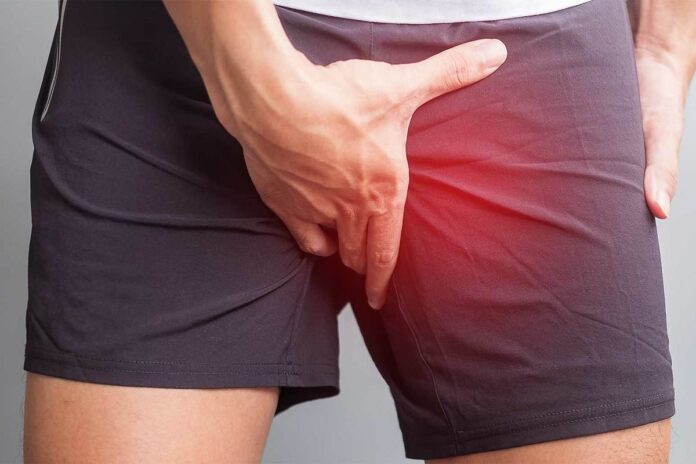Groin pulls or strains involve injuries to the adductor muscles, five muscles that start at the top of the thigh at the pubic bone and extend along the inner thigh to the inside of the knee. These muscles act to pull your legs in toward the midline of your body—for example, when you move from side to side when skating or while playing basketball or racquet sports. They’re also used during horseback riding, where inward thigh pressure is needed to maintain a stable riding posture. Crossing your legs and kicking a soccer ballsidewaysare two other activities in which your adductors are engaged. Injuries to the adductors can range from microscopic ruptures to major tears.
Table of Contents
Symptoms of groin strain
- A sudden sharp pain in the upper inner thigh, typically after a quick, explosive movement or overexertion.
- Extreme tenderness in the upper inner thigh.
- Increase in pain and stiffness with movement or continued activity.
- In severe cases walking may be painful enough to warrant the use of crutches for several days.
What causes groin strain?
The adductor muscles may be strained when you make a quick turn, or any timeyou’re involved in explosive running, jumping, twisting, or kicking actions or with intense, repetitive, side-to-side movement. Having weak adductor, gluteal (buttock), or abdominal muscles are also linked with an increased risk of groin strain. Other factors that may contribute include rapidly changing direction when running, sprinting uphill, abruptly changing your running terrain, jogging on a sloping beach, wearing shoes that don’t match your foot structure or function, or increasing running mileage too rapidly.
What if you do nothing?
A minor groin strain will heal itself within a few days. However, groin muscle pulls not only are painful, but they tend to recur. Exercises to strengthen and stretch the inner thigh muscles can help safeguard against this.
Home remedies for a groin strain
- Stop the activity. As soon as you feel pain in the inner thigh, stop exercising.
- Apply ice. Massage the sore spot with ice for 10 minutes and repeat four times daily for the next two to three days. How solid is this recommendation? Perhaps we should be less directive (e.g. “may help”).
- Support the muscle. Wrap the injured thigh with an elastic support bandage. A physical therapist may recommend a specific taping technique to take strain off of the muscle during activities.
- Try over-the-counter NSAIDs for pain relief. Nonprescription NSAIDs—aspirin, ibuprofen, and naproxen—may be taken according to label directions to relieve discomfort.
- Rehabilitate the muscles. A groin strain can become a nagging, recurrent injury unless properly rehabilitated. Rehabilitation can last from two weeks to as long as two years, depending upon your age and whether you’ve had a previous adductor injury (and, how severe the injury). A physical therapist can recommend a comprehensive rehab program that involves a variety of different range of motion, strengthening, andstretching exercises, including what’s referred to as “eccentric exercises,” in which the muscle lengthens (rather than shortens) as it works. (Note: You should avoid stretching during episodes of acute pain.)
How to prevent groin strain
One precaution against groin-muscle pulls is to make sure that weak muscles (including those in the groin) are strengthened. The following two exercises are a start and should help provide some protective benefits. Don’t do these exercises until you are free of pain, however.
Side lunge. Stand with toes pointed forward. Take a wide step to the right, keeping your feet pointing ahead and moving your body weight over your right foot as you bend that knee. Make sure the knee does not touch the toes. (Your left leg will be straight and extended out to the side.) Then, return the right leg to the starting position by pushing off of the right heel. Switch sides. Repeat 10 times.
Ball squeeze. In the lying position, place a soccer-size inflated ball between your feet and squeeze the ball by tightening your inner thigh muscles. Hold for 10 seconds. Repeat 10 times.
When to call your doctor
Contact your doctor if the pain is so bad that it makes it difficult for you to walk. Also, if the self-care measures described here fail to relieve the pain after several days, contact your physician or physical therapist. In rare cases an inguinal hernia—a tender lump or bulge in the groin—may mimic groin pull symptoms; consult your physician to rule out this possibility.
What your doctor will do
A physical exam will be carried out. (X-rays are rarely useful.) If a groin strain is suspected, anti-inflammatory medication will be prescribed to relieve pain. Your physician can refer you to a physical therapist who can recommend a course of rehabilitation.




